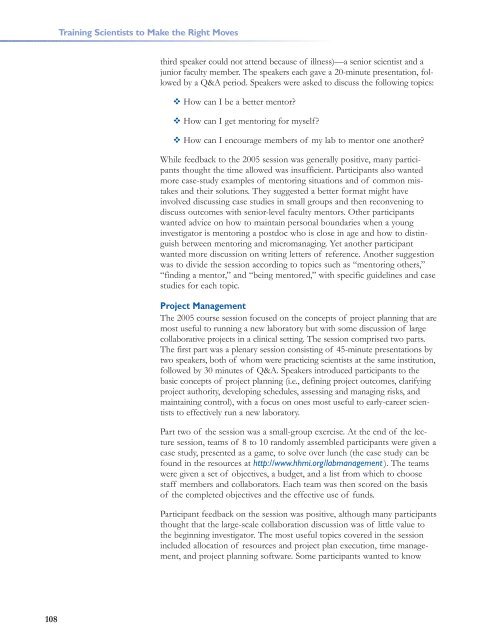Training Scientists to Make the Right Moves - Howard Hughes ...
Training Scientists to Make the Right Moves - Howard Hughes ...
Training Scientists to Make the Right Moves - Howard Hughes ...
Create successful ePaper yourself
Turn your PDF publications into a flip-book with our unique Google optimized e-Paper software.
<strong>Training</strong> <strong>Scientists</strong> <strong>to</strong> <strong>Make</strong> <strong>the</strong> <strong>Right</strong> <strong>Moves</strong><br />
third speaker could not attend because of illness)—a senior scientist and a<br />
junior faculty member. The speakers each gave a 20-minute presentation, followed<br />
by a Q&A period. Speakers were asked <strong>to</strong> discuss <strong>the</strong> following <strong>to</strong>pics:<br />
How can I be a better men<strong>to</strong>r?<br />
How can I get men<strong>to</strong>ring for myself?<br />
How can I encourage members of my lab <strong>to</strong> men<strong>to</strong>r one ano<strong>the</strong>r?<br />
While feedback <strong>to</strong> <strong>the</strong> 2005 session was generally positive, many participants<br />
thought <strong>the</strong> time allowed was insufficient. Participants also wanted<br />
more case-study examples of men<strong>to</strong>ring situations and of common mistakes<br />
and <strong>the</strong>ir solutions. They suggested a better format might have<br />
involved discussing case studies in small groups and <strong>the</strong>n reconvening <strong>to</strong><br />
discuss outcomes with senior-level faculty men<strong>to</strong>rs. O<strong>the</strong>r participants<br />
wanted advice on how <strong>to</strong> maintain personal boundaries when a young<br />
investiga<strong>to</strong>r is men<strong>to</strong>ring a postdoc who is close in age and how <strong>to</strong> distinguish<br />
between men<strong>to</strong>ring and micromanaging. Yet ano<strong>the</strong>r participant<br />
wanted more discussion on writing letters of reference. Ano<strong>the</strong>r suggestion<br />
was <strong>to</strong> divide <strong>the</strong> session according <strong>to</strong> <strong>to</strong>pics such as “men<strong>to</strong>ring o<strong>the</strong>rs,”<br />
“finding a men<strong>to</strong>r,” and “being men<strong>to</strong>red,” with specific guidelines and case<br />
studies for each <strong>to</strong>pic.<br />
Project Management<br />
The 2005 course session focused on <strong>the</strong> concepts of project planning that are<br />
most useful <strong>to</strong> running a new labora<strong>to</strong>ry but with some discussion of large<br />
collaborative projects in a clinical setting. The session comprised two parts.<br />
The first part was a plenary session consisting of 45-minute presentations by<br />
two speakers, both of whom were practicing scientists at <strong>the</strong> same institution,<br />
followed by 30 minutes of Q&A. Speakers introduced participants <strong>to</strong> <strong>the</strong><br />
basic concepts of project planning (i.e., defining project outcomes, clarifying<br />
project authority, developing schedules, assessing and managing risks, and<br />
maintaining control), with a focus on ones most useful <strong>to</strong> early-career scientists<br />
<strong>to</strong> effectively run a new labora<strong>to</strong>ry.<br />
Part two of <strong>the</strong> session was a small-group exercise. At <strong>the</strong> end of <strong>the</strong> lecture<br />
session, teams of 8 <strong>to</strong> 10 randomly assembled participants were given a<br />
case study, presented as a game, <strong>to</strong> solve over lunch (<strong>the</strong> case study can be<br />
found in <strong>the</strong> resources at http://www.hhmi.org/labmanagement ). The teams<br />
were given a set of objectives, a budget, and a list from which <strong>to</strong> choose<br />
staff members and collabora<strong>to</strong>rs. Each team was <strong>the</strong>n scored on <strong>the</strong> basis<br />
of <strong>the</strong> completed objectives and <strong>the</strong> effective use of funds.<br />
Participant feedback on <strong>the</strong> session was positive, although many participants<br />
thought that <strong>the</strong> large-scale collaboration discussion was of little value <strong>to</strong><br />
<strong>the</strong> beginning investiga<strong>to</strong>r. The most useful <strong>to</strong>pics covered in <strong>the</strong> session<br />
included allocation of resources and project plan execution, time management,<br />
and project planning software. Some participants wanted <strong>to</strong> know<br />
108
















